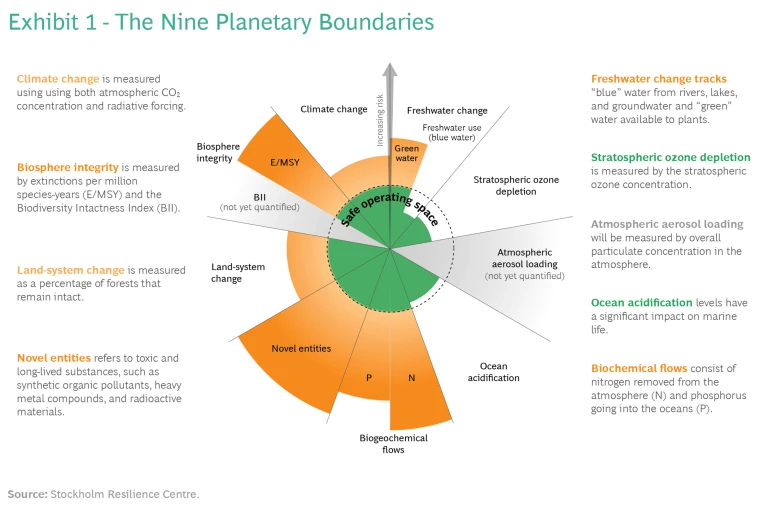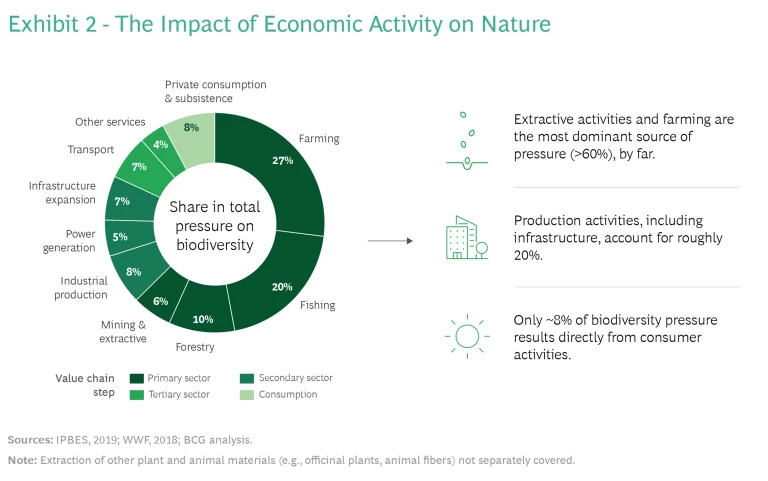Just as investors and other stakeholders now expect companies to reduce greenhouse gas emissions, soon companies will be expected to report and act on a much broader range of nature-related risks. These risks encompass a host of environmental and ecological impacts connected to $44 trillion in economic value generation, or nearly half of the total global GDP, according to the World Economic Forum.
What Are Nature-Related Risks?
Managing and mitigating nature-related risks will require a much wider lens than most companies have adopted to date. There are nine planetary boundaries that span our world—the land, sea, and atmosphere—and the life that it supports.
The planetary boundary that many are familiar with is climate change, but it is important to note that climate change is one of nine, with the others being biosphere integrity, land-system change, novel entities (such as toxic substances), freshwater change, stratospheric ozone depletion, atmospheric aerosol loading, ocean acidification, and biochemical flows. (See Exhibit 1.)

It is only when all nine planet boundaries are taken together, that companies can begin to evaluate their exposure to nature-related risks. To do that effectively, business leaders will need to adopt a mindset of “double materiality”—that is, they will need to think through how business activities may impact each of the boundaries and, as crucially, how each of the boundaries may impact business performance.
Although some companies have greater exposure to environmental and ecological degradation and collapse than others, the leaders of all companies need to adopt a more comprehensive approach to nature-related risks. As with climate change, customers, employees, and governments will demand it. In addition, investors will require it, especially large investors with diverse portfolios that are particularly vulnerable to the systemic threats arising from natural disasters and ecosystem collapse.
How Companies Impact and Depend on Nature
The nature-related impacts of industries stem in highly disproportionate degree from four value chains: food; infrastructure and mobility; energy; and fashion. BCG analysis shows that these four value chains are responsible for about 90% of the biodiversity loss. Of the four, food is by far the most significant, estimated to be responsible for at least 50% of the biodiversity loss. The value chains associated with infrastructure and mobility follow at approximately 25%, and then the energy and fashion value chains at approximately 10% each. In terms of activities, farming and fishing are the largest contributors to the impacts of these value chains. (See Exhibit 2.)

Companies don’t just have an impact on nature, many are also dependent on natural assets to operate. The World Economic Forum found that among the sectors highly dependent on nature were construction, responsible for $4 trillion gross value added; agriculture, responsible for $2.5 trillion gross value added; and food and beverages, responsible for 1.4 trillion gross value added.
Often, industries that exert the most pressure on nature are also most dependent on it. Australia’s rice industry grows a water-intensive crop on an infamously dry continent. Water consumption is one of this AUD$800 million industry’s greatest impacts on nature and also one of its greatest dependencies, with production volumes inherently tied to the volume of water available for use. Accordingly, the industry has invested more than AUD$85 million since 2012 to develop water-efficient varieties of rice that will help reduce its nature-related risks.
The Challenges of Reporting and Acting on Nature-Related Risks
The corporate responses to climate change to date can provide a rough map that companies can follow as they consider how to report on and respond to nature-related risks, but they won’t serve as a blueprint for several reasons.
First, as we discussed, nature-based reporting and action will need to cover a broader and more complex range of environmental concerns. These concerns should be methodically identified with a materiality analysis covering the full value chain of the company. In each sector, specific issues arise, such as deforestation, overfishing, water consumption in stressed areas, fragmentation of habitats in biodiversity hotspots, pollution, as well as dependencies on fragile ecosystems.
Nature-based reporting and action will need to cover a broader and more complex range of environmental concerns.
Second, climate impacts tend to be globally fungible, whereas nature impacts are local and, often, not interchangeable. In terms of global impact, it doesn’t matter where greenhouse gases are released or sequestered in terms of global impact, but the location of other impacts on nature do matter. The release of toxic waste in a lake and its remediation, for instance, may have a huge impact on the local environment, but little or no global impact. Thus, nature-related reporting and action is more complex: the aggregation of impacts may not be possible; and action in one area may not reduce overall impact in a significant manner.
Third, climate risks are focused primarily on fossil fuel combustion and scope 1 and 2 emissions, which can be calculated by multiplying operational data by established factors. Nature-related risks, on the other hand, are primarily focused on food and fiber products, which involve more complex value chains and a variety of risk factors that are often not well understood or defined. For instance, when Blackmores, Australia’s leading natural health company, sought to better understand the exposure of its ingredients and products to biodiversity risks, the company evaluated its global supply chain. The evaluation, the company reported, was “challenged by poor transparency, complex corporate structures and widespread use of contracted growers.”
Standards for Disclosure and Action on the Nature Transition Are Coming
Standards for managing nature-related risks are already forming. As with climate change, two kinds of standards are emerging: those that apply to disclosure and those that apply to preventive and remedial action.
Disclosure. The standards developed for emissions and climate-related risk are paving the way for nature-related risk reporting. In June 2021, the Taskforce on Nature-Related Financial Disclosures (TNFD) was formed. It is extending the leading climate risk and opportunity reporting framework created by the Taskforce on Climate-Related Finance Disclosures (TCFD) to a broader range of environmental exposures.
The standards developed for emissions and climate-related risk are paving the way for nature-related risk reporting.
Also in 2021, the demand for standardization across environmental reporting led to the creation of the International Sustainability Standards Board (ISSB), which plans to establish standards that extend to all nature-related exposures.
It is likely that the impetus behind nature reporting will be driven by investors and regulators, and it will probably be aligned with the emerging ISSB and TNFD standards. Within the European Union, for example, the Corporate Sustainability Reporting Directive (CSRD) will require all large companies to regularly report on their environmental and social impact activities. If adopted later this year, it will involve disclosing “all major environmental factors, including their impacts and dependencies on climate, air, land, water and biodiversity,” starting in 2024.
Action. Driven by investors, regulators, customers, employees, and other stakeholders, the Science Based Targets Network (SBTN) will likely set the bar for corporate action on nature. Formed in 2020, the SBTN is building on the work of the Science-Based Targets Initiative (SBTi), which verifies that corporate net zero and interim emissions reductions targets are aligned with the overall goal of limiting warming to 1.5°C above preindustrial levels. The SBTN aims to extend the concept of science-based targets from climate to nature. Just as SBTi clarifies the fair share of the global carbon budget that an industry and, therefore, a company can consume, SBTN aims to clarify the fair share of other environmental capitals. While corporate participation in SBTN and SBTi is optional, the standards that they set for action are likely to serve as the basis for regulations and laws in the future.
Three Initial Tasks in the Nature Transition
Increasing investor and stakeholder expectations and emerging reporting obligations suggest that the transition from climate to the wider, more comprehensive landscape of nature is just around the corner. To get ahead of the transition, leaders can undertake three initial sets of tasks:
Task set 1: Assess materiality, establish your baseline, and set targets. Leaders can begin to understand what the nature transition means for their companies by conducting a materiality assessment aimed at identifying their nature-related impacts and dependencies. Once identified, these impacts and dependencies need to be prioritized and then analyzed in greater depth to identify key metrics and their current baselines. After that, management can articulate its aspirations and commitments, and embed them in achievable targets.
In 2020, the French luxury goods conglomerate LVMH broadened its environmental aspirations with the adoption of its LIFE 360 environmental performance roadmap.
Task set 2: Build action plans for mitigating both impacts on the planet and risks to the business. The second set of tasks in the nature transition is aimed at identifying the actions needed to achieve the company’s goals. These actions can take four forms:
- Avoid and reduce by making operational improvements that reduce nature impacts and dependencies while generating cost savings.
- Transform and innovate by redesigning existing business models, processes, and products in ways that reduce nature risks, enhance the business performance, and contribute positively to the planet.
- Restore and regenerate by offsetting the remainder of impacts to deliver nature positivity.
- Create new green products and ventures by exploring products and business opportunities that rely on nature as a source of competitive advantage.
SunRice, one of Australia’s largest food exporters, for example, has used research and development investments and partnerships to develop new methods of growing rice—including direct drilling and delayed permanent water—and new varieties of rice. Together, they are helping the company produce some of the highest rice harvest yields in the world, while consuming 50% less water than the global average.
Task set 3: Put into place the infrastructure needed to support the nature transition.
The third set of tasks ensures that the infrastructure needed to make the nature transition are in place. This includes: the governance, organizations, and people needed to oversee and support the transition; the ecosystems and partnerships needed to provide leverage and expertise; and the internal capabilities, such as risk management, financial valuation, and monitoring tools, needed to execute the actions described above.
In pursuit of its Forest Positive Agenda for 2030, IKEA is reaching out and engaging with partners across its ecosystem. In 2021, for instance, the company extended its longstanding partnership with WWF through 2025. Together, they are protecting and improving forest management and fighting illegal logging, as well as working to reduce water and pesticide use in cotton farming. At the same time, IKEA enlisted its suppliers in the achievement of its nature goals by adding biodiversity requirements to IWAY, its supplier code of conduct.
Act Now, Refine Later
Companies should not wait to embrace the nature transition. First and foremost, leaders must protect their companies from nonlinear nature-related risks that could disrupt their businesses overnight and take years to remedy.
There are also first-mover advantages up for grabs. Companies that take the lead in the nature transition will be seen as pioneers, which will help them win over customers and investors and bolster their loyalty. It will make it easier to attract and retain talented employees. First movers will also be able to secure lower-impact inputs to production and position themselves for future success.
The nature transition is coming. With the COP15 to the UN Convention on Biological Diversity taking place in December in Montréal, a new Global Biodiversity Framework is expected to emerge, which will drive a new wave of regulatory pressure and open new business opportunities for nature positive businesses. The scientific community has now demonstrated that climate and biodiversity cannot be addressed as silos, and nature-based solutions are indispensable to address the climate crisis. Now is the time to plan how companies will integrate climate into a comprehensive social and environmental agenda.









